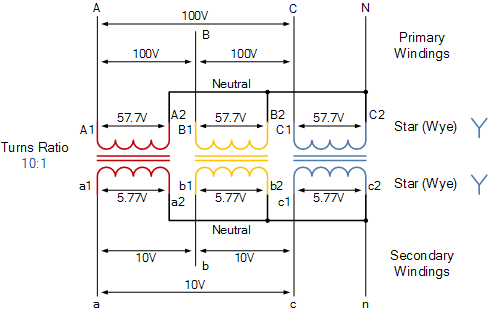Understanding Voltage Transformation: How Transformers Work
Ever wonder how electricity travels efficiently from power plants to your home? The secret lies in a device called a transformer, a silent workhorse of the electrical grid. Its primary function is manipulating voltage levels, a process crucial for efficient power transmission and safe usage in our everyday devices. This article delves into the fascinating world of transformers, exploring the intricacies of voltage transformation and its significance.
At the heart of a transformer's operation is the principle of electromagnetic induction. This phenomenon, discovered by Michael Faraday, describes how a changing magnetic field can induce a voltage in a nearby coil of wire. A transformer leverages this principle with two coils, the primary and the secondary, wound around a shared iron core. The voltage change occurs as the alternating current in the primary coil creates a fluctuating magnetic field, which in turn induces a voltage in the secondary coil. The voltage transformation is directly related to the ratio of the number of turns in the two coils.
The timing of voltage transformation is continuous and instantaneous. Whenever the voltage in the primary coil changes, a corresponding change is induced in the secondary coil. This continuous transformation is what allows transformers to adapt voltage levels to suit different applications, from long-distance power transmission to powering your laptop.
Historically, the need for efficient power distribution spurred the development of transformers. Early power systems struggled with significant energy loss due to high currents. Transformers provided a solution by allowing voltage to be stepped up for transmission, reducing power loss, and then stepped down for safe use in homes and businesses. This innovation revolutionized the electrical industry, paving the way for the extensive power grids we rely on today.
Understanding when voltage transformation happens is essential for comprehending the workings of modern power systems. The continuous and instantaneous nature of the transformation enables the efficient delivery of electricity across vast distances and its safe utilization in a myriad of devices. It allows us to harness the power of electricity in ways that were previously unimaginable.
A step-up transformer increases voltage while decreasing current, ideal for long-distance transmission where lower currents minimize energy loss. Conversely, a step-down transformer decreases voltage and increases current, making electricity safe for household appliances. For example, the transformer in your phone charger steps down the voltage from the wall outlet to a safe level for your device.
Three key benefits of transformers and their voltage-changing abilities are: efficient power transmission, ensuring device compatibility, and electrical safety. Efficient transmission minimizes energy loss. Device compatibility allows electronics to operate at their required voltage. Electrical safety is achieved by stepping down high transmission voltages to safer levels for consumer use.
Challenges associated with transformers include core losses due to magnetization and demagnetization of the core material and copper losses from resistance in the coil windings. Solutions involve using materials with lower magnetic hysteresis and higher conductivity. Another challenge is voltage regulation, maintaining a stable output voltage despite fluctuations in the input voltage or load. Solutions include tap changers that adjust the number of turns in the secondary coil.
Advantages and Disadvantages of Transformers
| Advantages | Disadvantages |
|---|---|
| Efficient Power Transmission | Initial Cost |
| Voltage Regulation | Maintenance Requirements |
| Electrical Isolation | Energy Losses (though minimized) |
Five real-world examples of transformers in action include power distribution transformers on utility poles, transformers in electronic devices like laptops and smartphones, transformers in electric vehicle charging stations, welding transformers that provide high current for welding, and instrument transformers used for measuring high voltages and currents.
Frequently Asked Questions about Transformers
1. What is a transformer? A device that changes voltage levels using electromagnetic induction.
2. When does a transformer change voltage? Continuously and instantaneously with changes in the primary coil's voltage.
3. Why is voltage transformation important? For efficient power transmission and safe device operation.
4. What are the types of transformers? Step-up and step-down transformers.
5. What are core losses? Energy losses due to magnetization and demagnetization of the core.
6. What are copper losses? Energy losses due to resistance in the coil windings.
7. How do transformers contribute to electrical safety? By stepping down voltage to safe levels for consumer use.
8. What are some applications of transformers? Power distribution, electronics, welding, instrumentation.
In conclusion, the transformer plays a critical role in modern power systems, facilitating the efficient transmission and safe use of electricity. Its ability to continuously and instantaneously change voltage levels is fundamental to the operation of electrical grids and a wide range of devices. Understanding the principles and importance of voltage transformation empowers us to appreciate the complex systems that power our world. From the large transformers on power lines to the miniature versions in our electronic devices, these unsung heroes work tirelessly to ensure we have reliable and safe access to electricity. By appreciating the complexities of voltage transformation, we can gain a deeper understanding of the technological marvels that shape our lives. Investing in further research and development of transformer technologies promises even greater efficiency and sustainability for future power systems, paving the way for a more electrified world.
Marylands money mind exploring the comptrollers office in baltimore
Ada wong resident evil 4 remake cosplay a deep dive
Unlock the power of you raise me up lyrics chords and piano tutorials












